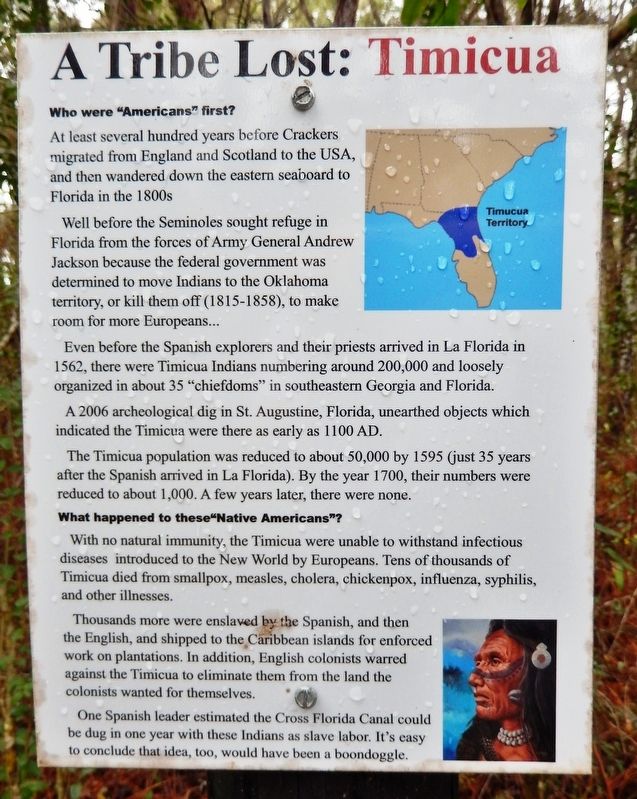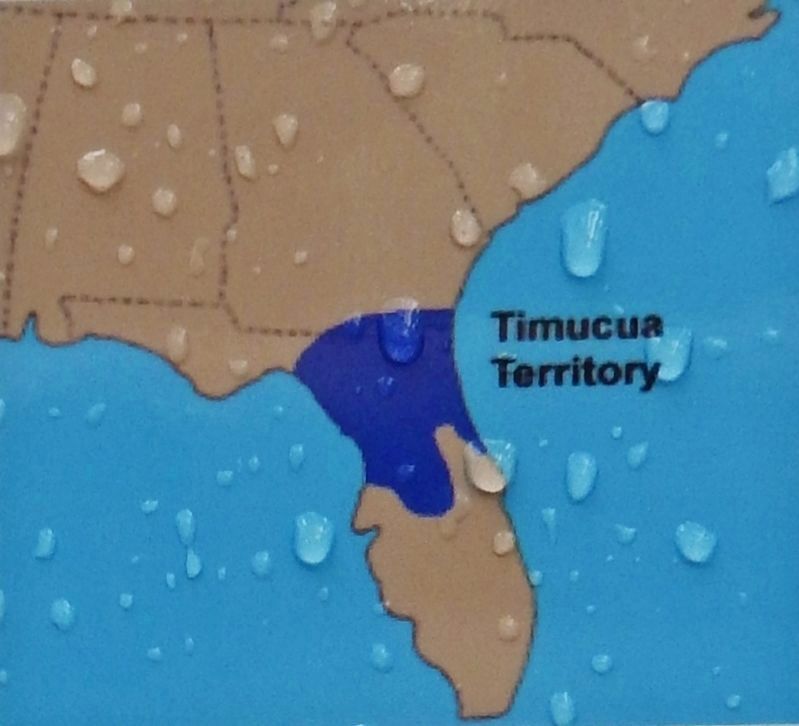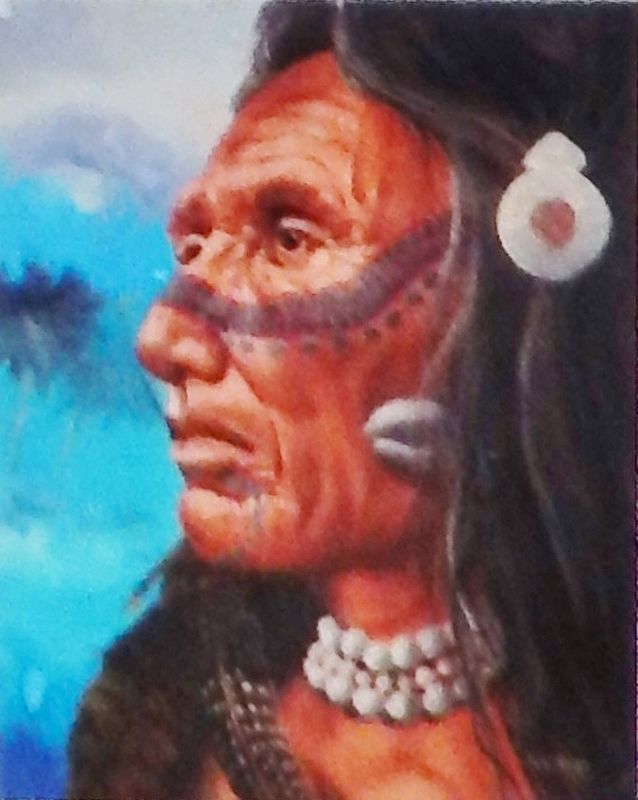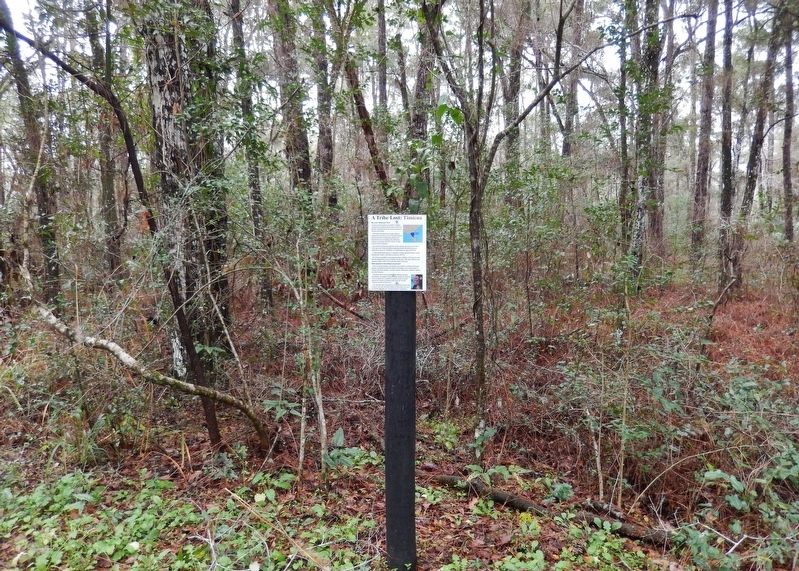Near Ocala in Marion County, Florida — The American South (South Atlantic)
A Tribe Lost: Timicua
Historic Florida Barge Canal Trail
Who were "Americans" first?
At least several hundred years before Crackers migrated from England and Scotland to the USA, and then wandered down the eastern seaboard to Florida in the 1800s
Well before the Seminoles sought refuge in Florida from the forces of Army General Andrew Jackson because the federal government was determined to move Indians to the Oklahoma territory, or kill them off (1815-1858), to make room for more Europeans...
Even before the Spanish explorers and their priests arrived in La Florida in 1562, there were Timicua Indians numbering around 200,000 and loosely organized in about 35 "chiefdoms" in southeastern Georgia and Florida.
A 2006 archeological dig in St. Augustine, Florida, unearthed objects which indicated the Timicua were there as early as 1100 AD.
The Timicua population was reduced to about 50,000 by 1595 (just 35 years after the Spanish arrived in La Florida). By the year 1700, their numbers were reduced to about 1,000. A few years later, there were none.
What happened to these "Native Americans"?
With no natural immunity, the Timicua were unable to withstand infectious diseases introduced to the New World by Europeans. Tens of thousands of Timicua died from smallpox, measles, cholera, chickenpox, influenza, syphilis, and other illnesses.
Thousands more were enslaved by the Spanish, and then the English, and shipped to the Caribbean islands for enforced work on plantations. In addition, English colonists warred against the Timicua to eliminate them from the land the colonists wanted for themselves.
One Spanish leader estimated the Cross Florida Canal could be dug in one year with these Indians as slave labor. It's easy to conclude that idea, too, would have been a boondoggle.
Erected by Florida State Parks.
Topics. This historical marker is listed in these topic lists: Anthropology & Archaeology • Colonial Era • Native Americans • Settlements & Settlers.
Location. 29° 6.126′ N, 82° 5.35′ W. Marker is near Ocala, Florida, in Marion County. Marker can be reached from the intersection of Southeast 80th Street (County Road 328) and South Pine Avenue (U.S. 441), on the right when traveling east. Marker is located along the trail at "The Island" - Cross Florida Barge Canal Interpretive Park, just south of the Marion County Sheriff's Station. Touch for map. Marker is at or near this postal address: 3260 Southeast 80th Street, Ocala FL 34480, United States of America. Touch for directions.
Other nearby markers. At least 8 other markers are within walking distance of this marker. Florida Seminoles (here, next to this marker); Florida Seminole Nations History (here, next to this marker); Oklahoma Seminole Nations History (here, next to this marker); Florida Crackers (a few steps from this marker); Cat Face (within shouting distance of this marker); Greenway Greenlife (within shouting distance of this marker); History: Crops (within shouting distance of this marker); Green Monsters (within shouting distance of this marker). Touch for a list and map of all markers in Ocala.
Regarding A Tribe Lost: Timicua. The most common spelling is "Timucua" but this marker shows "Timicua" — probably a spelling error.
Related markers. Click here for a list of markers that are related to this marker. Historic Florida Barge Canal Trail
Also see . . .
1. The Timucua: North Florida’s Early People. The Timucua all spoke dialects of the same language, although they were not united politically, living in different tribes with their own territory and dialects. When Europeans first arrived in Florida in the 1500s, the Timucua occupied over 19,000 square miles of land and their population was likely about 200,000. However, by 1800, there were no more Timucua left. (Submitted on February 25, 2021, by Cosmos Mariner of Cape Canaveral, Florida.)
2. Timucua Tribe – Lost Today. The Timucua were the Native American people living in the Northeast and North Central portions of what is now Florida. Their name may derive from the Spanish pronunciation of the Timucuan word atimoqua which means “lord” or “chief.” The Timucua probably numbered between 200,000 and 300,000 people organized into various chiefdoms speaking a common language. The earliest evidence of their presence dates from around 3000 BC. (Submitted on February 25, 2021, by Cosmos Mariner of Cape Canaveral, Florida.)
Credits. This page was last revised on February 25, 2021. It was originally submitted on February 20, 2021, by Cosmos Mariner of Cape Canaveral, Florida. This page has been viewed 265 times since then and 21 times this year. Photos: 1, 2, 3, 4. submitted on February 25, 2021, by Cosmos Mariner of Cape Canaveral, Florida.



